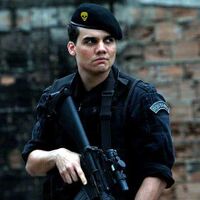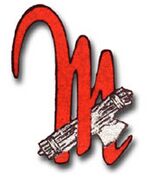Brigade "Etna"
| G.N.R. M Brigade "Etna" | |
|---|---|
| Brigata M G.N.R. "Etna" | |
 Brigade coat of arms | |
| Active | 1994-present |
| Country | |
| Branch | |
| Type | Light Infantry |
| Role | Internal Security |
| Garrison/HQ | Rome |
| Colours | Gold, Black and Red |
| March | Giovinezza |
| Anniversaries | 27 September |
| Commanders | |
| Current commander | Brigadier General Mario Moresco |
| Chief of Staff | Colonel Leopoldo Franchi |
The "M" Battalions are the elite units of the National Royal Guard, grouped under the command of the "Etna" Brigade and tasked with dealing with terrorist and insurgent crisis. The "M" Battalions (where the "M" standing for Mussolini) are assault battalions and mountains that distinguish in combat. The "M" Battalions undergo special training at the ""M" Battalions Field".
Despite their official role of providing additional anti-tank support to the police forces in a homeland defence scenario, the "M" Battalions are rumoured to be intended as a counterweight to the police in the event of a power struggle between the State and Party organisations.
History
The establishment of the "M" Battalions in the current form dates back to 1994, when several analysts underlined the growing hostility from Western great powers (mainly the United States, Germany and the United Kingdom) the Regime was going to face in the next years. The Counter-insurgency Command was established on 27 September 1994, and a month later it was transformed in a Regiment. Over the years, as paranoia increased, the Regiment was scaled up to the full Brigade size. With the start of the phenomenon of the Colour Revolutions the paranoia became actual fears, and detailed counter-insurgency plans were prepared.
Currently, there are 18 "M" Battalions of three kinds: Urban Counterinsurgency Battalions (8 Battalions), Rural Counterinsurgency Battalions (6 Battalions) and Counter-terrorist Battalions (4 Battalions); of the latter ones, all are under validation. 18 Battalions are framed within five Regiments (3-4 Battalions each) which in turn form the Brigade-sized command. The current commander is Brigadier General Mario Moresco.
Mission
The State apparatuses are organised chiefly to suppress and stifle intense and violent episodes of agitation, while Party forces are used for critical emergencies. Public Security, in particular, takes upon itself the task of addressing the riots, the insubordination to authority and banditry; Militia, through the National Royal Guard, has the task to cope with a terrorist or insurgent emergencies. In peace time "M" Battalions are usually employed directly by the Central Security Office, acting as the general reserve and support these reassigned to units engaged in actions which are particularly difficult, while in wartime they act as a general elite reserve force. In the official Italian military doctrine, such units should be able to operate both with and without the support of the territorial and "ordinary" M.V.S.N. to crack down peacetime disturbances.
Urban Counterinsurgency Battalions
For purposes of territorial defence and reserve operation to the needs of protecting public order, the Urban Counterinsurgency Battalions (Italian: Battaglioni Controguerriglia Urbana) have the value of a mechanized complex. The organization of a Mechanized Battalion is that of a mechanized unit supplemented by tanks and characterized by powerful firepower. The Urban Counterinsurgency Battalions are organized as follows:
- Command and command platoon
- Explorers Platoon
- 2 Mechanized Infantry Companies
- Mortars Company
- Tank Company
There are eight Urban insurgency Battalions, grouped under 1st and 2nd "M" Regiments.
- 1st "M" Regiment:
- 1st "M" Battalion "Teschio" (Turin);
- 2nd "M" Battalion "Pugnale" (Milan);
- 3rd "M" Battalion "Baionetta" (Verona);
- 4th "M" Battalion "Morte" (Bologna).
- 2nd "M" Regiment:
- 5th "M" Battalion "Spada" (Florence);
- 6th "M" Battalion "Fulgor" (Rome);
- 7th "M" Battalion "Lupo" (Naples);
- 8th "M" Battalion "Leone" (Palermo).
Rural Counterinsurgency Battalions
The two Rural Counterinsurgency Regiments (Italian: Reggimenti Controguerriglia Rurale) are in charge to carry out counterinsurgency warfare against insurgents in mountain areas and regions (Alps and Apennines). Methods include infiltration and day and night sudden, rapid raids, deep in the heart of the mountain bumps, stalking surveillance of places and people suspected, the wait and the capture of their prey.
Each Regiment consists of a Command-and-Support Company, of an Air Support Squadron Group (of the Air Service) and of three light infantry Battalions. Each infantry Battalion is made up of three identical Companies. In turn, each company is made up of a Captain, the Command Team and fifteen Teams, responsible for its own area of operation and enter into two Platoons (A and B). Within the A-Platoon there is a team composed entirely of rock climbers; within the B-Platoon there is a team of rock climbers enabled to mountain rescue. The Air Squadron Group is an helicopter-equipped battalion-sized unit which provides aircraft to the other Battalions and therefore consists of 3 Squadrons (company-level unit). In practice, each Air Squadron is assigned with its own Battalion and the higher level serves as an administrative support unit, with its command lying with the Regimental command itself.
The Rural Counterinsurgency Battalions are grouped under the 3rd and 4th "M" Regiments:
- 3rd "M" Regiment:
- 9th "M" Battalion "Sardinia" (Sassari);
- 10th "M" Battalion "Corsica" (Ajaccio);
- 11th "M" Battalion "Sicilia" (Enna).
- 4th "M" Regiment:
Counter-terrorism Battalions
The Counter-terrorism Battalions (Italian: Battaglioni Anti-terrorismo, B.A.T.) are units intended for armed intervention in instances requiring exceptional training, job complexity and risks that surround it. It operates at high risk of loss of life events, especially those involving: hostages, explosive devices, highly hostile elements and other complex events that require special training of personnel, weapons and equipment. These Battalions are also responsible for implementing complex public security operations, requiring a high degree of specialization of its professionals and use of techniques, tactics, weapons and special equipment and deactivation of explosive devices. Counter-terrorist Battalions are lighter supports for Urban insurgency Battalions, designed to provide a tool for surgical strikes.
Each of the Counter-Terrorism Battalions is organized as it follows:
- Command Platoon;
- Negotiation Squad;
- 4 x Tactical Companies: tasked with tactical interventions, each Company (about 100-strong) being able to carry out an independent operation;
- 1 x Snipers Platoon;
- 2 x Light Infantry Platoons (with armoured vehicles);
- 1 x Support and Transports Company: tasked with belting operations, as well as with heavy support (breaching vehicles, more armoured vehicles, etc.) in order to remove obstacles to accesses or streets. It consists of officers with expertise in mechanics and heavy explosives vehicles;
- 1 x Medical Platoon;
- 1 x Combat Engineers Platoon;
- 3 x Armoured Vehicles Platoons.
All four Counter-terrorism Battalions were validated in 2018; they are framed in a single Regiment:
- 5th "M" Regiment:
Uniform
Members of the "M" Battalions wear normal National Royal Guard uniforms, with the only difference of the black insignia on which the normal silver fasces is replaced by a fasces twisted with a letter "M" in red enamel, reproducing the Mussolini's handwriting. Also the banners of the various battalions take up the same symbols: on them, made in the shape of a dovetail, appear the same embroidered red "M" with Fasces, the words "Seguitemi" ("Follow me", expressing loyalty to Italian Motherland and to Fascism) with the same hand of the "M" and the Unit number.

